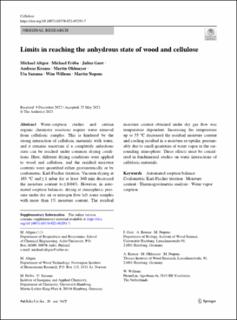| dc.contributor.author | Altgen, Michael | |
| dc.contributor.author | Fröba, Michael | |
| dc.contributor.author | Gurr, Julius | |
| dc.contributor.author | Krause, Andreas | |
| dc.contributor.author | Ohlmeyer, Martin | |
| dc.contributor.author | Sazama, Uta | |
| dc.contributor.author | Willems, Wim | |
| dc.contributor.author | Nopens, Martin | |
| dc.date.accessioned | 2023-09-22T13:13:12Z | |
| dc.date.available | 2023-09-22T13:13:12Z | |
| dc.date.created | 2023-06-02T12:47:15Z | |
| dc.date.issued | 2023-06-01 | |
| dc.identifier.citation | Altgen, M., Fröba, M., Gurr, J., Krause, A., Ohlmeyer, M., Sazama, U., Willems, W., & Nopens, M. (2023). Limits in reaching the anhydrous state of wood and cellulose. Cellulose, 30(10), 6247–6257. | en_US |
| dc.identifier.issn | 0969-0239 | |
| dc.identifier.uri | https://hdl.handle.net/11250/3091421 | |
| dc.description.abstract | Water-sorption studies and certain organic chemistry reactions require water removal from cellulosic samples. This is hindered by the strong interaction of cellulosic materials with water, and it remains uncertain if a completely anhydrous state can be reached under common drying conditions. Here, different drying conditions were applied to wood and cellulose, and the residual moisture contents were quantified either gravimetrically or by coulometric Karl-Fischer titration. Vacuum-drying at 103 °C and ≤ 1 mbar for at least 360 min decreased the moisture content to ≤ 0.04%. However, in automated sorption balances, drying at atmospheric pressure under dry air or nitrogen flow left some samples with more than 1% moisture content. The residual moisture content obtained under dry gas flow was temperature dependent. Increasing the temperature up to 55 °C decreased the residual moisture content and cooling resulted in a moisture re-uptake, presumably due to small quantities of water vapor in the surrounding atmosphere. These effects must be considered in fundamental studies on water interactions of cellulosic materials. | en_US |
| dc.language.iso | eng | en_US |
| dc.publisher | Springer Nature | en_US |
| dc.rights | Navngivelse 4.0 Internasjonal | * |
| dc.rights.uri | http://creativecommons.org/licenses/by/4.0/deed.no | * |
| dc.title | Limits in reaching the anhydrous state of wood and cellulose | en_US |
| dc.type | Peer reviewed | en_US |
| dc.type | Journal article | en_US |
| dc.description.version | publishedVersion | en_US |
| dc.rights.holder | © The Author(s) 2023 | en_US |
| dc.source.pagenumber | 6247-6257 | en_US |
| dc.source.volume | 30 | en_US |
| dc.source.journal | Cellulose | en_US |
| dc.identifier.doi | 10.1007/s10570-023-05293-7 | |
| dc.identifier.cristin | 2151194 | |
| cristin.ispublished | true | |
| cristin.fulltext | original | |
| cristin.qualitycode | 1 | |

